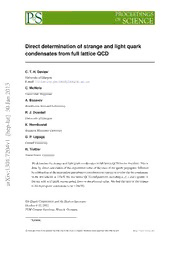
Direct determination of strange and light quark condensates from full lattice QCD PDF
Preview Direct determination of strange and light quark condensates from full lattice QCD
Direct determination of strange and light quark condensates from full lattice QCD C. T. H. Davies∗ UniversityofGlasgow E-mail: [email protected] 3 1 C. McNeile 0 2 UniversitätWuppertal n a A. Bazavov J BrookhavenNationalLaboratory 0 3 R. J. Dowdall ] t UniversityofGlasgow a l - K. Hornbostel p e SouthernMethodistUniversity h [ G. P. Lepage 1 v CornellUniversity 4 0 H. Trottier 2 7 SimonFraserUniversity . 1 0 WedeterminethestrangeandlightquarkcondensatesinfulllatticeQCDforthefirsttime.Thisis 3 donebydirectcalculationoftheexpectationvalueofthetraceofthequarkpropagatorfollowed 1 : bysubtractionoftheappropriateperturbativecontributiontoconverttoavalueforthecondensate v i intheMSschemeat2GeV.WeuselatticeQCDconfigurationsincludingu,d,sandcquarksin X theseawithu/d quarkmassesgoingdowntothephysicalvalue. Wefindtheratioofthestrange r a tothelightquarkcondensatetobe1.08(16). XthQuarkConfinementandtheHadronSpectrum, October8-12,2012 TUMCampusGarching,Munich,Germany ∗Speaker. (cid:13)c Copyrightownedbytheauthor(s)underthetermsoftheCreativeCommonsAttribution-NonCommercial-ShareAlikeLicence. http://pos.sissa.it/ StrangeandlightquarkcondensatesfromlatticeQCD C.T.H.Davies 5 5 R R, m = physical s l l 4 4 3 3 2 2 1 1 0 0 0 1 2 3 4 5 6 0 1 2 3 4 5 6 a-2 (GeV2) a-2 (GeV2) Figure1:ResultsforR ,definedinEq.2.1,asafunctionofthesquareoftheinverselatticespacing.Theplot q ontheleftisforsquarksandontherightforlightquarksatthephysicallightquarkmass(m =(m +m )/2). l u d Opensquaresgiverawresultsandpluseshavetree-levelperturbativecorrections. Crosseshaveinaddition one-loopperturbativecorrections,usingα(nf=4)(2/a).Dashedlinesgiveasimplelinearfittotherawresults. V 1. Introduction The condensation of quark-antiquark pairs in the vacuum signalling the breakdown of chiral symmetryisanimportantfeatureoflowenergyQCD.Thevalueofthechiralcondensate(thequark condensateforzeroquarkmass)isgivenbytheGell-Mann,Oakes,Rennerrelation[1]: f2M2 m +m (cid:104)0|uu+dd|0(cid:105) π π =− u d . (1.1) 4 2 2 A value for the chiral condensate can be extracted accurately but indirectly from chiral extrapola- tion of lattice QCD results for meson masses and decay constants. A harder question to answer is that of the value of the light and strange quark condensates at their physical non-zero quark masses. This is because the condensate must be carefully defined, taking into account the quark mass dependent mixing of mψψ (not normal-ordered) with the unit operator. On the lattice, in a direct calculation of the condensate, such mixing gives rise to terms which diverge as m/a2. We have calculated these terms, through O(α ) in lattice QCD perturbation theory and used these to s convert the lattice QCD results to a well-defined condensate in the MS scheme at a fixed scale (2 GeV).Sincewehaveresultsatmultiplevaluesofthelatticespacingwecanfitforremainingm/a2 pieces at higher order in α . We can also extrapolate our results to the continuum limit at a=0. s Since the conference we have finalised a paper on this work [2] and refer the reader there for all details. 2. Results WeusegluonfieldconfigurationsgeneratedbytheMILCcollaborationincludingu, d (m = u m here), s and c quarks in the sea at 3 different values of the lattice spacing and having u/d d quark masses down to the physical value [3]. The quark formalism used is the Highly Improved StaggeredQuark(HISQ)action[4]thathasgoodchiralpropertiesandsmalldiscretisationerrors. 2 StrangeandlightquarkcondensatesfromlatticeQCD C.T.H.Davies Figure1showsourrawandcorrectedlatticeresultsforsquarksandforlightquarksofphysical mass. ThequantityplottedistheratioR givenby: q 4m (cid:104)ψψ (cid:105) q q R =− . (2.1) q f2 M2 ηq ηq Here η is the pseudoscalar meson made from quarks of mass m . This is the π for light quarks q q andafictitiousparticlecalledtheη forsquarks. Wedonotincludedisconnecteddiagramsinthe s η correlator and so it is unable to decay to gluons or to mix with the physical η and η(cid:48) mesons. s Because it has no valence light quarks, yet is not a heavy meson, it is a very useful particle in the determination of the lattice spacing [5]. Its mass and decay constant in the continuum and chiral limits can be determined accurately in terms of those of the K and the π [6]. Interestingly, values very close to those expected in leading order chiral perturbation theory are found. R is a good q quantity to use in this analysis because it has reduced finite volume and quark mass dependence overthecondensatealoneandis1forquarksofzeromass,asgivenbytheGMORrelation. InFigure1theopensquaresgivetherawresultsfromthelattice,determiningthecondensate from the trace of the quark propagator. The x-axis is the inverse square of the lattice spacing and it is quite clear from these plots that there is a quark-mass dependent 1/a2 divergence. The pluses give the results after subtraction of the difference of the tree-level lattice QCD (for HISQ quarks) and MS perturbative expressions. The divergence is largely, but not entirely, removed. The crosses continue this process by removing the perturbative contribution through O(α ). This s makeslittledifferencebecausethecoefficientoftheO(α )divergenceisverysmall. Itisthenclear s that the remaining divergence evident in the lattice calculations must come from higher orders in perturbation theory, and we take account of this in our fits. We also use the fact that the form of thedivergenceisstronglyconstrainedandfitsimultaneouslyresultsatmultiplevaluesofthequark massandlatticespacing. Figure 2 on the left shows the one-loop subtracted results from Figure 1 along with the final resultsfromourfit. Thex-axisisnowthesquareofthelatticespacingandthegreyandgreenbands showthecontinuumandchirallimitvaluesofthestrangeandlightquarkcondensatesrespectively, intheMSschemeat2GeV.Ourfitformallowsfordiscretisationerrorsandquarkmassdependence of the physical condensate as well as the divergent pieces discussed above. Fitting the remaining divergenceisthekeyissueindeterminingthefinalerror,however,andthereasonwhytheerroron the strange quark condensate is 15% and on the light quark condensate 0.5%. Full details, along withanerrorbudget,aregivenin[2]. Ourresultsare: (cid:104)ss(cid:105)MS(2GeV) = −0.0245(37)(3)GeV3=−(290(15)MeV)3 (cid:104)ll(cid:105)MS(2GeV) = −0.0227(1)(4)GeV3=−(283(2)MeV)3 (cid:104)ss(cid:105)MS(2GeV) = 1.08(16)(1), (2.2) (cid:104)ll(cid:105)MS(2GeV) where the first error comes from our fitted result for R and the second error in each case comes q fromtheerrorinthequarkmasses,takenfromlatticeQCDresults[7]. Figure 2 shows on the right a comparison of our result for the ratio of the strange to light quarkcondensatetopreviousvaluesfromQCDsumrulecalculations[8,9,10]. Ourresulthasthe 3 StrangeandlightquarkcondensatesfromlatticeQCD C.T.H.Davies Lattice QCD this work 1.8 R s,phys R 1.6 l,phys 1.4 Maltmann et al 1.2 0811.1590 1 R q Dominguez et al 0.8 0711.3962 0.6 Narison et al 0.4 hep-ph/0202200 0.2 0 0 0.5 1 1.5 2 0 0.005 0.01 0.015 0.02 0.025 0.03 - - a2 (fm2) <ss(2 GeV)>/<ll(2 GeV)> Figure 2: The figure on the left shows the results from fitting the ratio R given by the crosses after sub- q tracting the perturbative contribution through O(α ). 4 different quark masses are used: m (black), m /5 s s s (blue),m /10(red)andthephysicallightquarkmass(green). Thegreenandblackbandsshowthephysical s resultfromthefitwith±1σ errors. Blackisforthestrangequarkcondensateandgreenforthelightquark condensate. Thefigureontherightshowsthecomparisonofourresultfortheratioofstrangetolightquark condensatetothoseofprevioussumruleanalyses. advantageofbeingadirectdeterminationwithafullerrorbudget. Ourvalueforthestrangequark condensateagreeswellwithindependentresultsongluonfieldconfigurationsincludingu,d ands quarksintheseaandcoveringawiderrangeofvaluesofa[2]. References [1] M.Gell-Mann,R.Oakes,B.Renner,Phys.Rev.175:2195(1985). [2] C.McNeileetal,arXiv:1211.6577 [3] A.Bazavovetal(MILCCollaboration),arXiv:1212.4768. [4] E.Follanaetal(HPQCDCollaboration),Phys.Rev.D75:054502(2007),hep-lat/0610092. [5] C.T.H.Daviesetal(HPQCDCollaboration),Phys.Rev.D81:034506(2010),arXiv:0910.1229. [6] R.J.Dowdalletal(HPQCDCollaboration),Phys.Rev.D85:054509(2012),arXiv:1110.6887. [7] C.McNeileetal(HPQCDCollaboration),Phys.Rev.D82:034512(2010),arXiv:1004.4285. [8] K.Maltman,Phys.Lett.B672:257(2009),arXiv:0811.1590. [9] C.A.Dominguezetal,JHEP0805:020(2008),arXiv: 0712.0768. [10] S.Narison,hep-lat/0202200. 4
